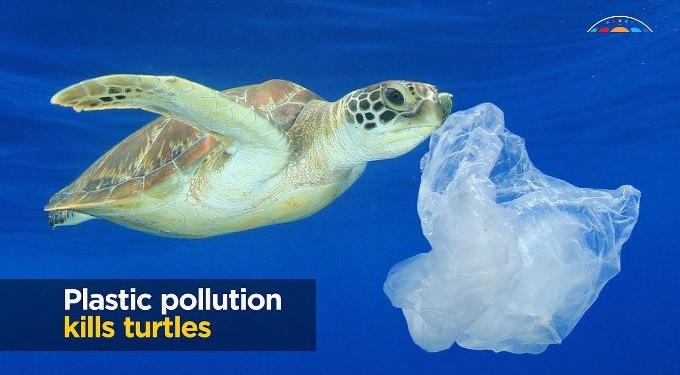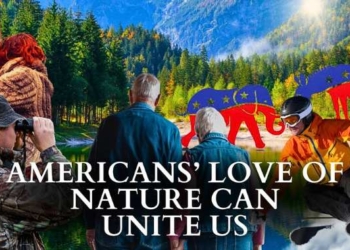
An endangered green sea turtle off the coast of Mexico.
Three out of seven global sea turtle species are endangered
Seven species of sea turtles call our world’s oceans home, three of which are endangered: Kemp’s ridley sea turtle, the hawksbill turtle, and the green sea turtle. Of these seven types of sea turtles, six are found in the United States and protected under the Endangered Species Act (ESA). The International Union for the Conservation of Nature (IUCN) estimates that there are just over 22,000 mature Kemp’s ridley turtles, primarily found in the Gulf of Mexico, left in the wild. Population numbers or trends are unknown for the hawksbill turtle, which jumped from endangered to critically endangered in 1996, though the IUCN predicts an 80% decrease over three generations due to habitat degradation. Populations of green turtles, endangered since 1982, are unfortunately decreasing as well.
Threats
Approximately 61% of worldwide turtle species are either threatened or already extinct, and the sea turtle is no exception. The Caribbean Sea alone was home to tens of millions of sea turtles just two centuries ago, but numbers are estimated closer to the tens of thousands these days. Like many other marine vertebrates, sea turtles are threatened by bycatch, illegal poaching, habitat loss, climate change, and pollution. Sea turtles are especially susceptible to light pollution and degradation of nesting habitats, which can interfere with egg-laying.
Bycatch
Sea turtles are accidentally caught in fishing or shrimping nets, and even on longline hooks, on a regular basis. This is typically a death sentence unless the fishery makes a substantial effort to release them. Even then, since sea turtles need to breathe oxygen regularly, it is often too late to save an animal that becomes entangled. In 2007, fishing bycatch accounted for about 4,600 annual sea turtle deaths in the United States, with a massive 98% occurring in the southeast Gulf of Mexico.
Illegal Trade
All around the world, sea turtles are overharvested and illegally poached for their meat and eggs as sources of food and income. Although the international trade of all species of sea turtles and their parts is banned under the Convention on International Trade in Endangered Species of Wild Fauna and Flora (CITES), illegal poaching is not uncommon.
Researchers from Current Biology developed and field-tested 3D printed decoy sea turtle eggs to uncover trade trafficking routes using a GPS transmitter that emitted one signal per hour. Decoys were placed in 101 turtle nests on four beaches throughout Costa Rica, and a whopping 25% were illegally taken. They were able to trace five eggs — two from green sea turtle nests and three from vulnerable (but formerly endangered) olive ridley nests — to just outside of a residential property and 1.24 miles to a local bar. The farthest decoy traveled a total of 85 miles over two days from the beach to a supermarket, assumed to be a handover point between trafficker and seller.
To get a better idea of what drives illegal turtle hunting, researchers conducted interviews with eight sea turtle poachers from five different communities in Baja California Sur, Mexico, from June 2007 to April 2008. They found the biggest drivers influencing their behavior to be economic benefits, lack of law enforcement (combined with corrupt law enforcement easing escape or bribery if caught), and family tradition.
Coastal Development
Unsustainable coastal development, whether for hotels or residential high rises, can disturb or destroy sea turtle nesting habitats. Some threats are obvious, like increased boat traffic, dredging, or sand filling, but other lesser-known complications can arise from issues like vehicle traffic on the beach itself, which can compact sand and make it difficult for females to dig nests.
Setback regulations, which prohibit construction within a certain distance from the ocean, are often not enough to mitigate nesting beach loss. In a study of 11 popular sea turtle nesting sites in Barbados, researchers modeled sea-level rise scenarios under five setback regulations, finding that sea turtles preferred nesting within the lowest regulation distances of 10 and 30 meters. Under all three scenarios, the beach area was lost from models with a 10- and 30-meter setback, and some with even a 50- or 70-meter setback.
Did you know that egg temperature can determine the sex of a sea turtle’s offspring during incubation? Warmer air and sand temperature can easily result in fewer male hatchings, thus disrupting efficient reproductive patterns. A recent study of loggerhead turtles (listed as vulnerable by the IUCN) predicted sex ratios under anticipated global warming scenarios, finding that populations of turtles in the United States would become ultra female-biased with a 1 C increase in air temperature. Warmer sea temperatures can also lead to increasingly severe storms, which can destroy nesting beaches or the reefs where turtles like to forage.
Pollution
It is no secret that plastic waste often finds its way to the ocean. Some species of sea turtles have highly specialized diets, like the vulnerable leatherback sea turtle, which feeds almost entirely on jellyfish, or the hawksbill turtle, whose diet consists primarily of sea sponges. Sea turtles can mistake plastic bags for jellyfish or smaller debris for fish, algae, or other food sources.
Based on models off the east coasts of the U.S., Australia, and South Africa, and the East Indian Ocean and Southeast Asia, it’s estimated that up to 52% of sea turtles have ingested trash. In Brazil, a study of 50 dead stranded sea turtles found that plastic ingestion was the cause of death for 13.6% of the green sea turtles examined. A similar survey of loggerheads in the Adriatic Sea found marine debris inside the intestinal tracts of 35% of turtles, 68% of which were soft plastics.
An increase in artificial light pollution from coastal infrastructure is another severe threat to nesting sea turtles, accounting for the loss of close to 1,800 sea turtles in the Caribbean over the last two decades. Lights from hotels and other buildings can discourage females from nesting or cause hatchlings to become disoriented and wander in the opposite direction of the ocean.
What We Can Do
Beloved sea turtle species have received a lot of attention, but there is still plenty of work to do. Protection from the ESA has been essential in sea turtle conservation, as at least six sea turtle populations have significantly increased following measures triggered by ESA listing (such as tailored species management and fishery regulations). Organizations like the World Wildlife Fund help raise awareness for sea turtles and work with local communities to work on ways to develop alternative economic opportunities so communities don’t need to rely on turtle harvesting. They have also collaborated with the National Oceanic and Atmospheric Administration to reduce turtle bycatch in gillnets by developing special fishery lights, which has shown to reduce bycatch by 60% to 80%.
An amendment to the Marine Mammal Protection Act in 1994 made several changes to how bycatch of sea turtles was regulated. These included the authority to place observers on vessels in fisheries with frequent or occasional sea turtle mortality and requirements to report when a turtle has been killed or injured during commercial fishing operations. A study conducted by the Biological Conservation peer-reviewed journal found an annual mean of 346,500 turtle bycatch interactions, resulting in an estimated 71,000 yearly deaths before establishing these bycatch mitigation measures. After mitigation measures, sea turtle bycatch and bycatch-caused mortality decreased by 60% and 94%, respectively.
Individuals can help sea turtles by learning about smarter seafood choices through organizations like the Marine Stewardship Council and teaching their friends and families about the impact of sustainable fishing. They can also protect sea turtle habitat by supporting turtle-friendly tourism and choosing vacation establishments that take steps to keep nests safe on their beaches, turn lights off at night, implement beach monitoring programs, and properly inform guests. Lastly, do your part to reduce pollution by limiting plastic use, restricting single-use plastics (especially plastic bags!), and participating in beach cleanups.
















